Alpha 900 launch: Press Conference Part 4
Duncan McEwan spoke, in his usual very steady and friendly manner, about his experience of using the Alpha 900. He showed a selection of images taken – remarkably – over a period of just 10 days preceding the event, using a 24-70mm CZ and his own 70-200mm Minolta SSM. Here is his own ‘script’ for the presentation, with a small selection of the images.
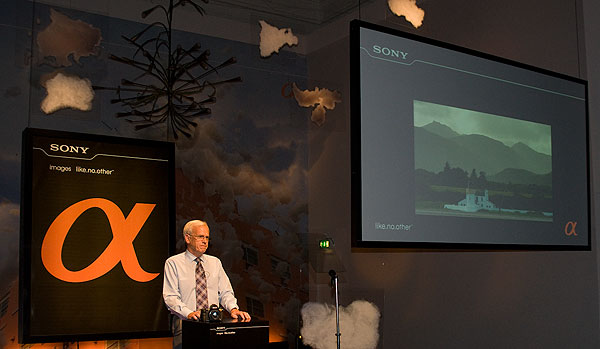
Duncan starts his picture show
I have been using Minolta cameras and lenses since 1970 with great satisfaction and success. The acquisition of a KM Dynax 7D marked my entry point to digital imaging, replacing this with a Sony A100 about 18 months ago. I still love film and have been reluctant to let go of it completely – I guess I shoot about 50/50 film and digital, appreciating the relative merits of each medium.
In early September I had the privilege and pleasure of using the Sony A900 for a couple of weeks with the Carl Zeiss 24-70mm f2.8 SSM – a real cracker of a lens. The only other lens used was my own Minolta 70-200mm f2.8 SSM which has a direct Sony equivalent.
Why me? I cannot claim to represent top end professionals, but I do think I am representative of a significant sector of the market that the A900 will appeal to.
So how does the A900 offer what I need from a camera? I want a camera to capture faithful colour, light quality and crisp detail/definition leaving me to concentrate on compositional aspects.
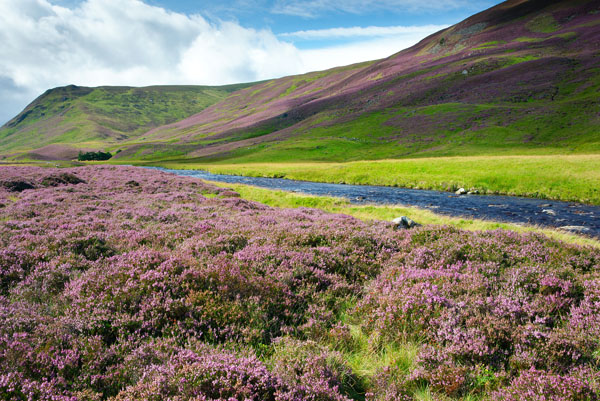
Glen Clunie, near Braemar
COLOUR – the rendition of colour impressed me greatly. The range of colours encountered in the Scottish landscape were handled in a most pleasing manner. Blue flowers have always been notoriously difficult to record accurately on film and I was amazed at the accuracy of the colour produced (note: for this comment, Duncan showed a shot of a blue flower).
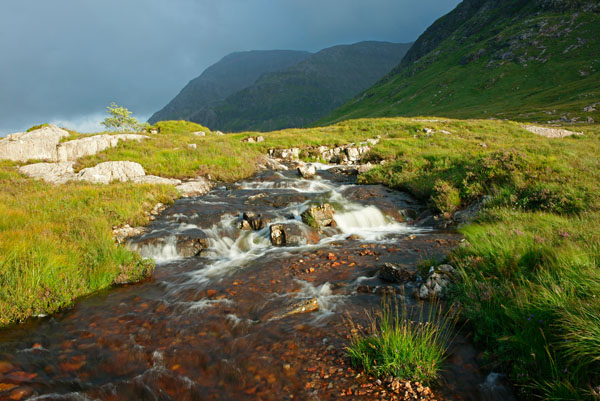
Glen Coe
The Creative Style Menu provides the opportunity for in-camera processing of colour to suit specific situations and subjects. Although many will prefer to apply these at the RAW conversion stage the excellent in-camera processing will be welcomed by many users.
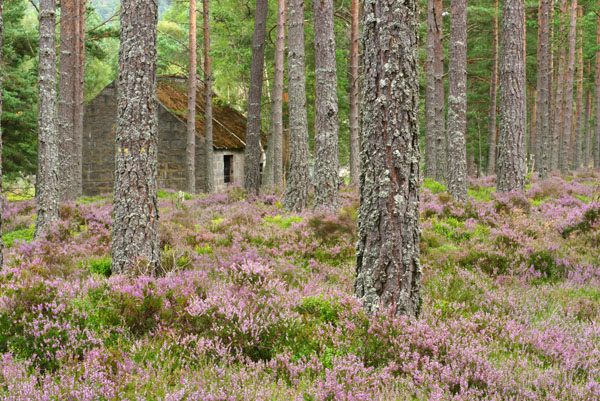
Deeside Pine Woods
Very overcast conditions gave lovely accurate muted colours, portraying scenes accurately.
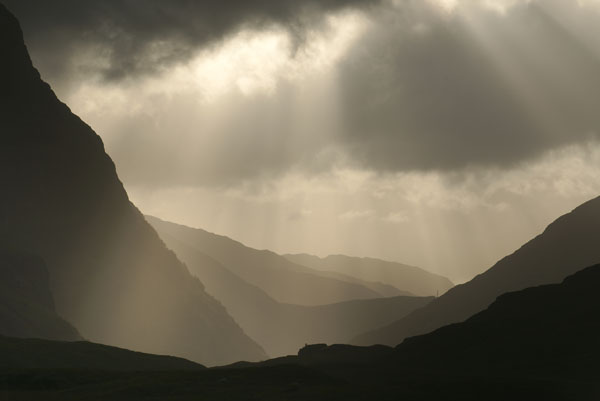
Glen Coe Light
CAPTURING THE LIGHT – The quality of images made in less than ideal lighting conditions was most impressive as was the performance in more dramatic lighting situations where the contrast range is often much greater. I was left in no doubt that here was a camera that could deliver all I required for my own photography.
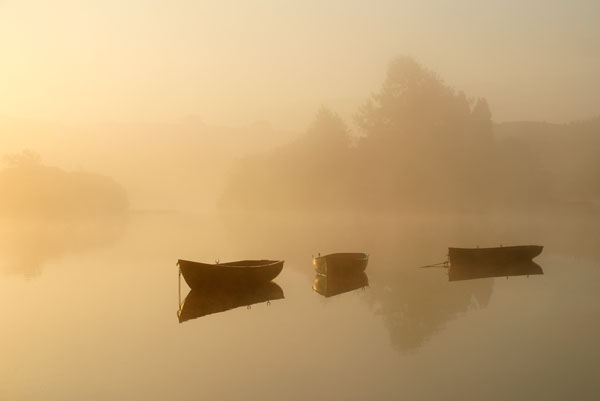
Knapps Loch, Kilmacolm
EXPOSURE ACCURACY was very good with only minimal adjustments at times – much less than I have been accustomed to with the Alpha 100. A third of a stop either was about all that was needed to produce perfect histograms, even with night time exposures of 15 to 20 seconds. The exception was for light toned subjects such as mist but was no more than expected for this type of subject.
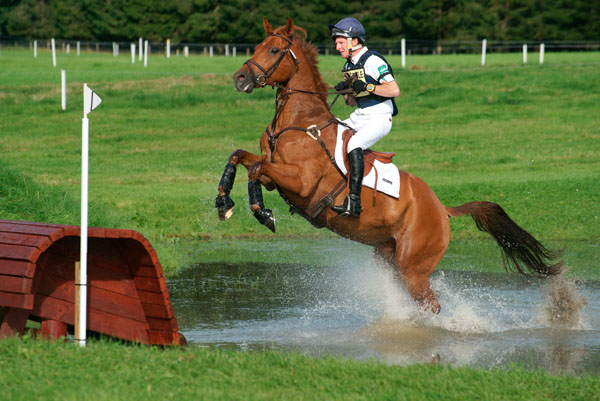
Blair Horse Trials
AUTOFOCUS was easily the best I have used. It was fast and positive.
The continuous AF was up to the task of following moving subjects and coupled with a drive speed of 5 frames per second, the Alpha 900 is well equipped to serve the needs of sport/action photographers. Focus hunting seemed was rarely encountered and only in situations that were entirely predictable, such as mist.
The ISO RANGE. Although the range is from 100 to 6400, 100/200 ISO were mostly used for landscapes but mid-range values of 400/800 were excellent for sporting subjects. The higher ISO settings were not extensively explored, although on floodlit buildings at ISO 3200, the performance was outstanding in terms of sharpness with low noise levels and less saturated colours. ISO 200 ISO is reputedly the optimal setting for the camera.
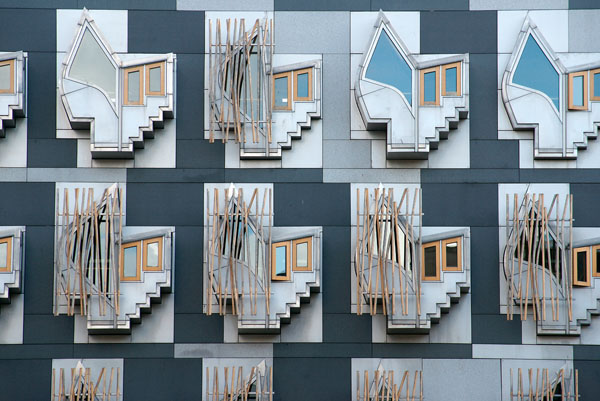
Scottish Parliament Facade
FINE DETAIL – it is amazing what fine detail can be recorded by a 24.6mp sensor especially when using quality optics such as the 24-70 CZ lens.
D-RANGE OPTIMISER was found to have value in contrasty situations and has a choice of settings from standard to various advanced settings. The standard setting produced subtle changes and could safely be left switched on.

Scottish Parliament Reflections
I feared at the outset that it would take me time to get to grips with the camera, but I need not have worried. The A900 is easy to use, and a delight to use. It felt really good to hold from the moment I first picked it up and it no heavier or bulkier than you would expect for a professional camera. Processing and transferring so much information requires a lot of battery power and I quickly found that CF cards bought for the 7D were no longer adequate for a full size sensor.
The brightness of the viewfinder is exceptional – subjects looking almost as bright through the viewfinder as in reality, a fact made obvious when shooting in dull light or when taking night time shots. Indeed, dull weather photography became quite inviting. It also makes one appreciate detail at the taking stage, which should be very useful in macro work, and also when manual focusing is being used.
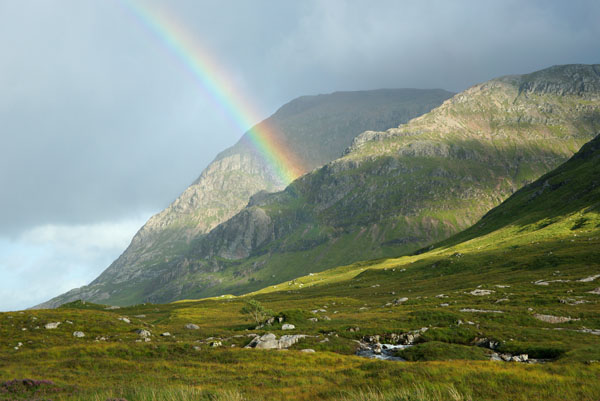
Glen Coe Rainbow
The Alpha 900 has a fantastic range of functions and with the CZ lens and the 24.6mp sensor, delivers amazing quality. All the features I would expect in a professional camera are there – a mix of innovation and tried and tested ones. The key functions are button operated by very well positioned buttons and the multiselector has a real positive feel. One button is left for the user to assign a specific function which is very useful. The Custom button has a dual function depending on whether you are in shooting or viewing mode – in the latter it brings up the histogram display. A lot of flexibility has been built into the custom functions, accessed through user friendly scroll-down menus.
The high resolution 7.5cm LCD screen gives the best display that I have used.
In such a high tech piece of equipment, it was refreshing to find that simple ‘traditional’ features such as a true mirror lock-up and a built-in eyeshield had been included. The mirror lock-up is in addition to a 2 second mirror lock-up delay and is a feature that will be particularly useful in macro photography. The eyeshield makes life easier than using clip-on protectors and its use contributes to much more accurate exposures when bright light is striking the rear of the camera.
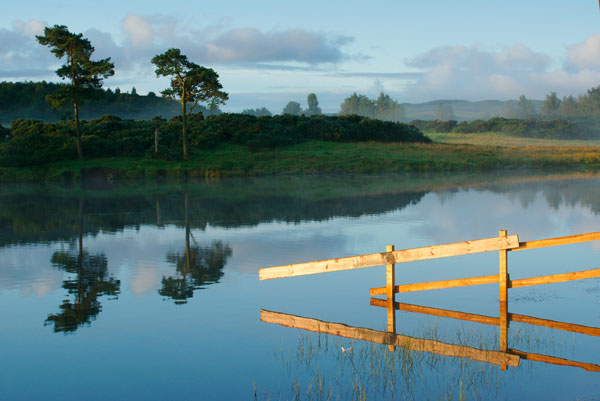
First light, the Knapps Loch, Kilmacolm
At the end of the trial period I was left with the feeling that my attachment to film was considerably weakened due to the superb quality of the images captured. The Alpha 900 certainly fulfilled my photographic requirements and expectations – big time!
Be prepared to be impressed!
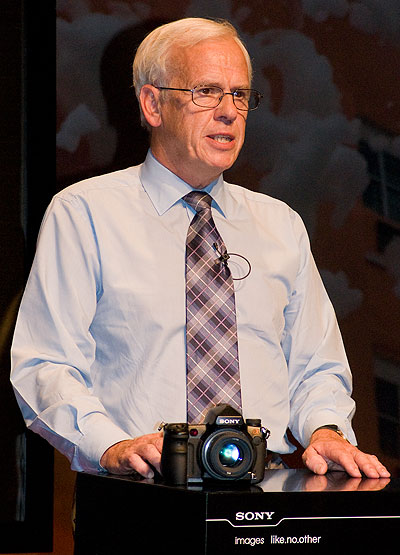
Duncan McEwan
Duncan McEwan is Scottish Region Organiser for the Photoworld Club (photoclubalpha). He lectures throughout the UK, is a much-requested competition judge, has a fine track record with stock libraries and his calendar and postcard views can be found used in publications sold by throughout Scotland. He organises a number of courses, leads workshops at the Inversnaid Photography Centre, and organises an annual open day for the club in Edinburgh. See: http://www.duncanmcewan.co.uk
Next: transcripts from the press workshop on the Alpha, if anything clear can be deciphered.
To start reading this coverage of the European Alpha 900 launch from the start click here.

Been looking forward to this part of the report, after the article about Duncan in Photoworld 2008#1 – thanks for yours [& Shirleys] efforts in these reports…
Difficult to judge the quality on the basis of these small images but the colours are lovely and I am quite prepared to take Duncan McEwan’s word for it that this is a wonderful camera for the advanced amateur and probably a lot of professionals once the capabilities of the camera and Sony’s high end lenses become more known to a wider audience. This may take some time judging from looking at the Nikon and Canon forums. I went from being an MD shooter to Sony’s A700 and A350 so I could have chosen any digital system without having to ditch legacy lenses. I chose Sony as I had faith in their ability and commitment. The A900 has confirmed to me that this was not a bad choice although I have no current need for a FF DSLR. I like the approach to provide a first class still camera with a sensor designed to get the best possible image from excellent lenses. IMHO I think Canon have made an error in cramping too many pixels into their 50D and added Video instead of producing a quality still image successor to their 40D. Likewise Nikon seem to have fixated themselves on 12 Mp FF rather than exploiting the full capabilities of the FF sensor. It will be interersted to see if they do release an MX medium format camera as rumoured. If they do surely they will divert resources from DX and FX to the detriement of their position in this market segment. I think Sony has made a statement and in time they may become No. two in the DSLR market. Who knows?
Thanks for that David, good to read Duncan’s opinion of the A900.